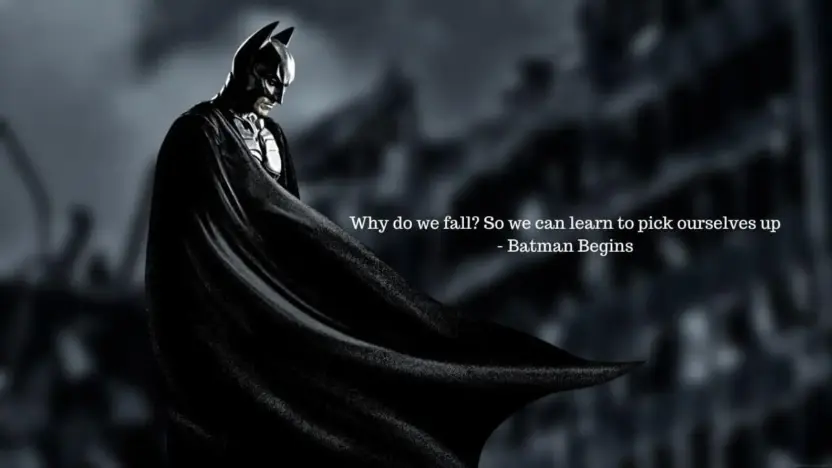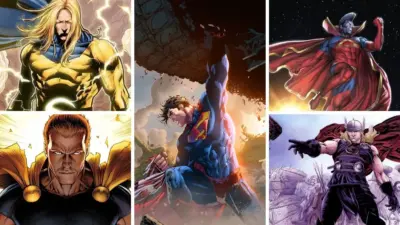Among the many captivating scenes and dialogues that define Batman, one quote from the film “Batman Begins” remains particularly memorable and inspiring: “Why do we fall? So we can learn to pick ourselves up.” Uttered in a moment of vulnerability and introspection, this simple phrase encapsulates a profound truth that goes beyond the fictional universe of superheroes. This quote is more than just a line from a film; it’s a philosophy that speaks to the human condition, resonating with our innate ability to grow through adversity and failure. Whether you’re a fan of the caped crusader or someone seeking wisdom in everyday life, this statement has the power to inspire and guide.
Philosophical Undertones
This statement from “Batman Begins” is not just a motivational line; it’s a philosophical mantra that encapsulates timeless wisdom. Whether viewed through the lens of Stoicism, existentialism, Eastern philosophy, or modern psychology, it speaks to the indomitable human spirit and our ability to transform through adversity. Let’s break down the philosophical layers embedded in this statement:
- Perseverance and Resilience: At its core, the quote is an ode to human resilience and the power of perseverance. It echoes the Stoic philosophy, which emphasizes strength and endurance in the face of hardship. Just as Batman rises after each fall, so too are we capable of overcoming life’s obstacles.
- Growth through Failure: The idea that we learn and grow through our failures aligns with various Eastern and Western philosophical thoughts. From Confucianism’s emphasis on self-cultivation to modern psychological theories on growth mindset, the concept of learning from failure is a recurring theme.
- Existential Courage: The courage to face our fears, accept failure, and then rise again resonates with existentialist thinking. It challenges us to confront life’s uncertainties and to find meaning and purpose in our struggles.
- The Hero’s Journey: This quote can also be viewed through the lens of Joseph Campbell’s “Hero’s Journey,” a narrative pattern that has influenced countless stories across cultures. The fall and subsequent rise symbolize the trials and transformations that are essential to personal growth and self-realization.
- Yin and Yang: From an Eastern perspective, the quote aligns with the Taoist concept of Yin and Yang, where opposite forces are interconnected and complementary. The fall (Yin) and the rise (Yang) are two sides of the same coin, each giving meaning and context to the other.
- Ethical Responsibility: Batman’s commitment to justice and moral integrity underlines a sense of ethical responsibility that finds echoes in Kantian ethics. The decision to rise after a fall reflects a commitment to one’s principles and a sense of duty to oneself and others.
- Human Potential: Finally, this quote celebrates the unlimited potential within each of us. It’s a reminder that, like Batman, we possess the inner strength and wisdom to overcome challenges and evolve.
Applicability to Real Life
While the world of Batman may be filled with larger-than-life villains and heroic escapades, the wisdom contained in this quote is remarkably relevant to our everyday lives. The essence of the quote speaks to the universal human experience of failure and the potential for growth that resides within each setback. Here’s how it applies to various aspects of real life:
- Personal Growth and Self-Discovery: Failure is often seen as a negative outcome, but this quote reframes it as an opportunity for self-discovery and personal growth. It encourages us to embrace our failures as learning experiences that shape our character and guide our future decisions.
- Career and Professional Development: In our careers, setbacks and failures are inevitable. Whether it’s a missed promotion, a project that didn’t pan out, or a career transition, the ability to rise after a fall is crucial. This quote reminds us that these challenges are stepping stones towards success, encouraging us to persevere and adapt.
- Relationships and Emotional Resilience: Relationships can be complex and often fraught with misunderstandings and disappointments. The wisdom in this quote teaches us to approach relationship challenges with emotional resilience, learning from our mistakes, and growing stronger in our connections with others.
- Education and Learning: For students and lifelong learners, this quote is a reminder that failure is an essential part of the learning process. Rather than being deterred by mistakes or setbacks, we can view them as opportunities to deepen our understanding and sharpen our skills.
- Health and Wellbeing: In the journey towards physical or mental wellness, setbacks are not uncommon. Whether it’s a lapse in a diet, a struggle with mental health, or a sports injury, the ability to rise again and continue striving towards our goals is vital. This quote offers motivation and perspective on the path to well-being.
- Entrepreneurship and Innovation: Entrepreneurs and innovators often face rejection and failure. This quote speaks to the entrepreneurial spirit, emphasizing the importance of resilience, adaptability, and the courage to continue pursuing one’s vision, even in the face of adversity.
- Social Activism and Community Involvement: For those engaged in social causes and community efforts, challenges and disappointments are part of the journey. The message in this quote resonates with the persistent fight for justice, equality, and positive change.
Conclusion
The words “Why do we fall? So we can learn to pick ourselves up” are more than just a rallying cry for a fictional superhero; they are a reflection of our shared human experience. They remind us that failure is not a dead-end but a crossroad, a place of learning, growth, and potential transformation.
Whether in the world of business, relationships, personal development, or community activism, this quote challenges us to view our setbacks with a new perspective. It invites us to embrace our falls not as defeats but as opportunities, encouraging us to rise with renewed strength, wisdom, and purpose.
Also Read: The best way to predict the future is to create it



